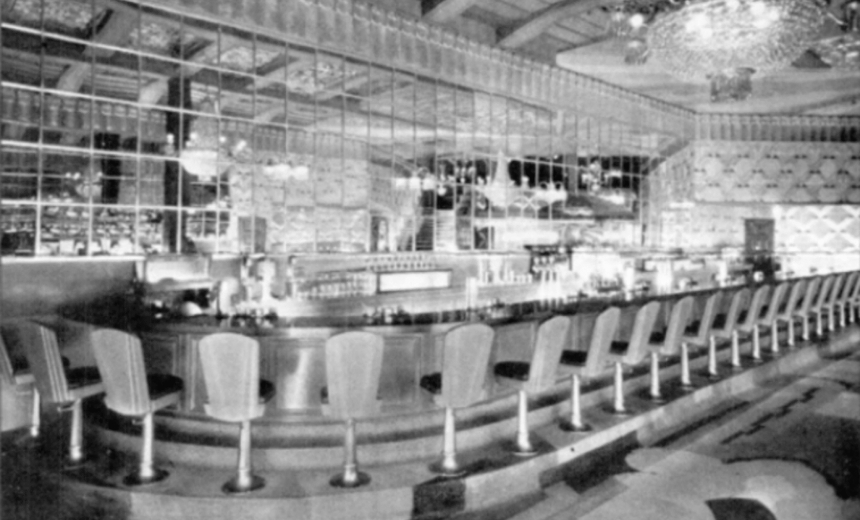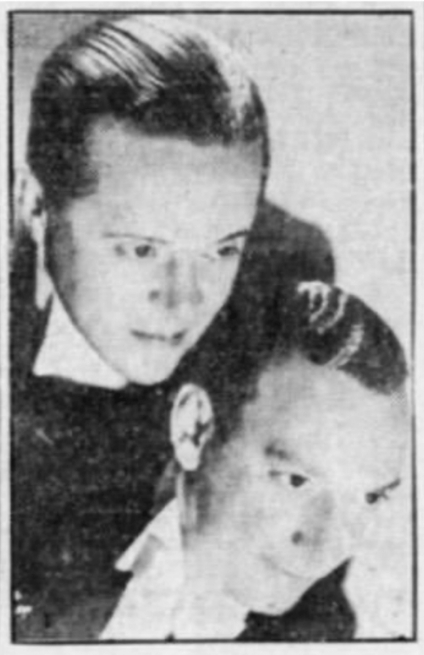
1930 |
Pig’n Whistle

1936 |
Leo Deslys & Keno Clark
1906
Earthquake and fires of April 1906 destroyed downtown San Francisco.
1907
In 1907, real estate investor Morris Siminoff commissioned architects Shea & Shea to design a two-story commercial building at 1028-1056 Market Street historically known as the Golden Gate Building.
1914
The 1914 Red-Light Abatement Act shut down the city’s brothels, forcing prostitution into the streets, which led to the Tenderloin becoming the center of San Francisco’s sex trade – for straight, gay and transgender prostitutes.
1920s
In the early 1920s, several important theaters and movie palaces developed in the neighborhood and a portion of the Golden Gate Building was converted into a second-run movie theater.
1925 – 1936
The Pompeii Theater, 1046 Market Street (this site), opened with 398 seats and operated from 1925 until 1933. After an Art Deco style remodel in 1935-36, the theater was renamed the Regal.
1930
The Pig’n Whistle, a restaurant chain with locations throughout the West Coast, opened at 1032 Market Street on September 12, 1930 until in 1941.
1933
Following the repeal of Prohibition in 1933, queer bars and nightclubs proliferated in San Francisco, similar to national trends.
1943
The Crystal Bowl restaurant was opened at 1032 Market Street, by owner Sidney E. Wolfe, a notorious figure nicknamed the “Tavern King of San Francisco” who also had interests in numerous gay businesses in the Tenderloin and around town.
1948
The Golden Gate Building housed as many as 12 businesses, including the theater, a billiards hall, and numerous stores and restaurants.
1951
After favorable California State court rulings which essentially legalized gay and lesbian bars in San Francisco, proprietors were more openly serving the LGBTQ crowd and the atmosphere became more open.
1953
Keno Clark, a former vaudeville performer, operated several LGBTQ nightclubs and restaurants, including Keno’s 47 Club (47 Golden Gate Avenue) located at the rear of the Crystal Bowl at 1032 Market Street. It was one of many gay bars that had front and back entrances to allow exits in the case of a police raid.
1955
An amendment to the California Business and Professional Code allowed authorities to investigate any bar functioning as a “resort for sexual perverts.”
1956
The Crystal Bowl closed after losing its liquor license amid other legal troubles.
Keno’s 47 Club also closed, likely due to a lost liquor license that would have been shared with the Crystal Bowl.
1959
A bookshop specializing in Western Americana and rare books opened in the former Keno’s 47 Club space.
1963
The demolition of the 1929 Fox Theater, the West’s finest movie palace with 4,650 seats, marked the beginning of the end of Market Street’s great entertainment era.
1970
The Market Street Beautification Project began. The multi-year refurbishment introduced brick sidewalks, granite crosswalks, sycamore trees, kiosks, benches, bus shelters, and domed phone booths.
1974 – 1989
In late 1974, the former Regal Theater space was taken over by X-rated film moguls, the Mitchell Brothers, who reopened it as the Bijou Theater, also known as the Mitchell Brothers Bijou.
1986
The Market Street Theatre and Loft National Register Historic District is designated. The district was determined to be significant for its association with the development of motion picture houses, as an important commercial corridor, and for its impressive architecture.
1989 – 2005
The Bijou Theater shut down operations in 1989, but the space reopened in the mid-1990s with a live show and video booths before finally closing for good in 2005.
2005 – 2017
The former theater space at 1046 Market is converted to use as a food hall and bar.
2019
Demolition of the building at 1028-1056 Market Street begins in October 2019, replaced by Prism – a new mixed-use apartment building